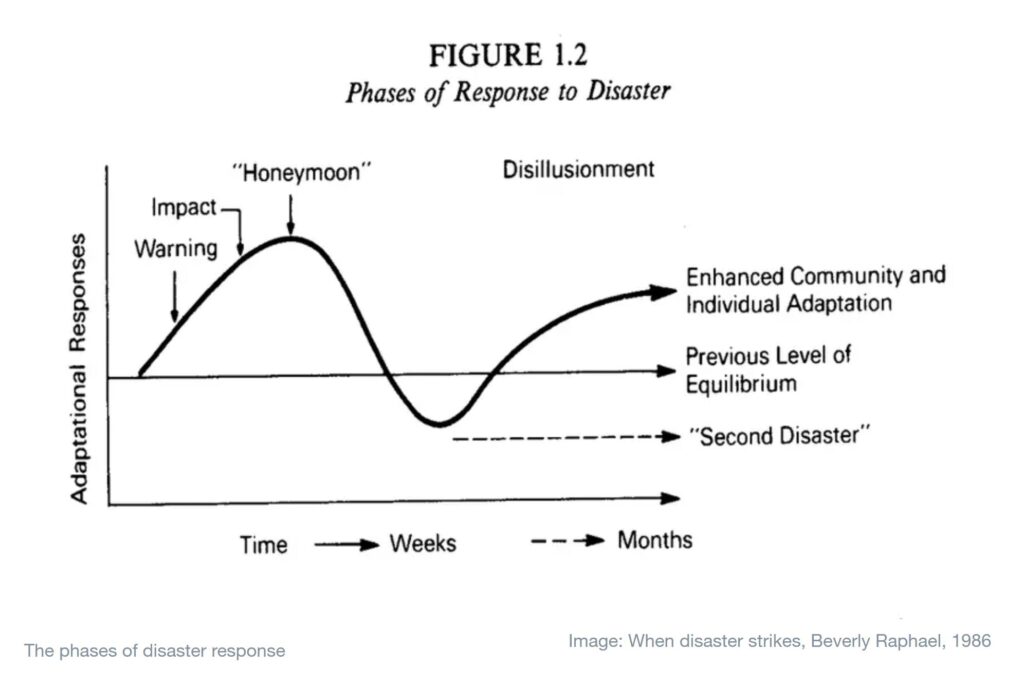Getting Ahead of the Next Curve as a Leader and Team: What We Need to Know About Human Disaster Response and Trauma
Getting Ahead of the Next Curve as a Leader and Team: What We Need to Know About Human Disaster Response and Trauma
There is no doubt that we have been going through a season of much higher fear, anxiety, and trauma with the COVID-19 crisis and the very visual revealing of social and racial injustice and inequities.
Our stressors are also multi-faceted and connected with different concerns.
On one hand, our concerns are related to health, economics, isolation, and an uncertain and non-uniform re-opening. On the other hand, our concerns are related to seeing gaps in long-standing social constructs associated with equality, justice, and inclusion.
Even as we begin to work through the “peaks” medically and in terms of concern over our organization’s near-term financial health… and as we begin to better listen, understand, and take new actions as citizens and society… the fact is, that we will not – and must not – just return to “normal”.
On the medical side, life as we knew it at the start of 2020 is likely at least many months away once we have an effective and widely available vaccine. Where exactly we end up organizationally and socially will depend on us.
“On the medical side, life as we knew it at the start of 2020 is likely at least many months away once we have an effective and widely available vaccine. Where exactly we end up organizationally and socially will depend on us.”
–Peter C. Atherton, PE
Between then and now, however, there are things we need to know and steps we need to take to help ease concerns and come out of these periods of crisis stronger, better, and more resilient.
What we need to know
There will continue to be a dip.
No matter how well we have responded as an individual, team, or organization to these situations to date, we will see a dip. The fear, anxiety, and trauma we’ve experienced and are experiencing is similar to that of a disaster.

As shown in the graphic above, there is a natural human response to a disaster.
It just makes sense too – even when comparing to a simple, yet stressful event we often experience and can largely control. If we switch out the word “disaster” and adjust the timing, we experience a similar curve with adrenaline and mindset in response to a “major presentation” or “major project deliverable”.
In this analogy, we have a “warning” that a deadline is coming, we ramp up focus and production and have “impact” as we make sacrifices with our normal day-to-day activities in order to deliver what’s needed and achieve “honeymoon” status once we’ve successfully done what we needed to do.
There is then a dip the next day or over the next several days in both physical energy and our outlook. Even when we’re confident that we performed well, we may question some things or wish we could have done better. In those instances, we can quickly return to “normal” with an enhanced feeling of accomplishment, and even more ready for the next presentation or project. In cases where we didn’t perform well or know we could have done more, the dip may be greater and last longer until we are more resilient as a result.
In the case of the COVID-19 pandemic, leaders and leadership teams have heeded the “warning”, taken “impact”, and met at least the first of what could be multiple peaks.
In the case of our changing social constructs, we’re earlier in the curve and learning more.
The issue we must be aware of for both COVID-19 and social equality and justice, however, is not short-term physical adrenaline – it’s longer-term psychological stress and strain, and even burnout and disengagement.
What we need to do now
First, we need to better understand what is happening and what’s likely to come next.
Here is a link to a World Economic Forum Article that presents data and perspectives on what we’re up against in terms of a secondary COVID-related epidemic of burnout and stress-related absenteeism in the workplace and includes the graphic presented above.
A similar response curve is likely to apply to the trauma and stresses related to fully visualized racial injustices and inequities and our calls for change.
My recommendation is to review this information and response sequence openly with your leadership team and talk about how it applies.
You should also:
- Talk about what you did and are doing right, what you wish you could do over, and what you would do differently as the waves and the work continues.
- Share about where you are individually and as a team.
- Determine how you can best share and discuss this information with – and get feedback from – your managers and your organization as a whole.
If we want to be in a position to effectively respond and even get ahead of the curve while avoiding possible “second disasters” and periods of disillusionment, we all need to know what’s likely to come next.
“If we want to be in a position to effectively respond and even get ahead of the curve while avoiding possible ‘second disasters’ and periods of disillusionment, we all need to know what’s likely to come next.”
–Peter C. Atherton, PE
No matter how you’ve responded to date, taking the lead now as leaders and leadership teams gives us the best opportunity to connect with and walk-through the next and final phases of these moments better, faster, stronger, and more resilient.
It is also our best path to enjoy the benefits of higher levels of employee engagement, loyalty, and retention long after we return to new and better “normals”.
Please reach out to me if you’d like to discuss more about this and outline strategies that can work best for you and your organization during these critical periods of change.
To your winning,

PS – Are you or your team feeling overwhelmed, or are you burning out? There is a big difference and each requires a different approach. Take this FREE quiz to find out where you stand and learn exactly how you can get back on track by clicking HERE.
PSS – Do you want to learn how to excel and prevent burnout in you and your organization? Check out relevant and important chapters of my book “Reversing Burnout” for FREE by clicking HERE.
Check out too the AEC Leadership Today Podcast designed exclusively for leaders who want to stay relevant and effective and help their firms grow and prosper during all times >> HERE!

Pete Atherton
About the Author
Peter C. Atherton, P.E. is an AEC industry insider with over 30 years of experience, having spent more than 24 as a successful professional civil engineer, principal, major owner, and member of the board of directors for high-achieving firms. Pete is now the President and Founder of ActionsProve, LLC, author of “Reversing Burnout. How to Immediately Engage Top Talent and Grow! A Blueprint for Professionals and Business Owners”, and the creator of the I.M.P.A.C.T. process.
Pete is also the host of The AEC Leadership Today Podcast and leads The AEC Leadership Mastermind.
Pete works with AEC firms to grow and advance their success through modern and new era focused strategic planning, executive coaching, leadership and management team development, performance-based employee engagement, and corporate impact design. Connect with him through the contact link below.


